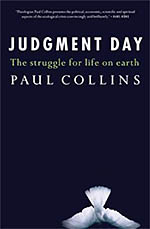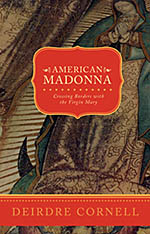Book Reviews: Judgment Day: The Struggle for Life on Earth by Paul Collins, and American Madonna: Crossing Borders with the Virgin Mary by Deirdre Cornell
Paul Collins, Judgment Day: The Struggle for Life on Earth (Orbis Books, 2011. Paperback. 291pp. $22.00).

With Judgment Day, Paul Collins, an Australian Catholic religion writer and historian, nudges Christian environmentalism in the tougher, no-holds-barred direction favored by some secular environmentalists. The book’s title signals such a shift. Collins’s eight galvanizing chapters—the first, “Cursed”—lay out the specifics of the judgment human beings are bringing on themselves. “It is no use kidding ourselves,” he tells us, “…that (we) will somehow find a technological fix for the damage we have wrought …we are presiding over an unnatural apocalyptic extinction that results directly from our activities and decisions.”
While indicting modern consumerism and narcissism in general, Collins is particularly critical of the ecologically oblivious anthropocentrism of many of the world’s religions, and the failure of religious leaders to intervene forcefully in the crisis. The Catholic unwillingness, especially under Pope John Paul II, to confront the pivotal problem of overpopulation comes in for denunciation. Similarly, Collins maintains, “Little or nothing of significance has been heard from the US (Catholic) bishops on environmentalism.”
One of the strengths of Collins’s book is its comprehensiveness. Early chapters on global warming and population lay out the parameters of the crisis. His chapter on the environmental dimensions of the Hebrew and Christian scriptures would make an excellent resource for a congregational study group. A chapter on Catholic and Protestant “geologians,” from Francis of Assisi through Pierre Teilhard de Chardin and Thomas Berry, is likewise useful. And the conclusion, in which Collins turns to deep, “trans-religious” ecumenism and a new “poeticizing” imagination as a way beyond the environmental crisis, is provocative and inspiring.
Yet, I have some concerns about this book. Collins shares one of my deepest fears about the crisis bearing down on us, that participative democracies are ill suited to deal with its extremely tight time frame. Yet Collins’s book in some respects displays the very tendencies toward crisis-induced, hierarchical domination that he also worries about. His use of the phrase “environmental thugs” to characterize Christians and others who are destroying the environment may be justified, but it also conjures up the very people I fear will be enforcing environmentalism before long. His tendency throughout the book to write in the first person plural reminds me of a classmate at the black seminary I attended who confronted a lecturer with the question, “Who ‘we’ white girl?” Is there really not even one female “geologian” or environmentalist whose work Collins could have drawn upon? Or can we no longer afford such trivial matters in this age of environmental crisis?
My greatest concern about Judgment Day, however, is that Collins’s chapter on “geologians” culminates in the environmental thinking of the German philosopher Martin Heidegger, and Collins returns to Heidegger in his concluding argument. Heidegger was one of the great philosophers of the twentieth century, and he influenced a large number of other leading thinkers. But he was also a Nazi, and a significant number of scholars argue that his Nazism and his philosophy are, in fact, linked.
In particular, Collins’s use of Heidegger’s condemnation of technology is troubling, because it is reminiscent, in some respects, of the Nazi ideological invocation of the romantic naturalness of the German people, the “Aryan volk.” Perhaps Collins’s reading of Heidegger manages to avoid Heidegger’s Nazism, but the fact that Collins doesn’t so much as refer to it is troubling in itself. If we are left with a choice between environmental destruction and even moderate forms of fascism, we are truly between a rock and a hard place. As Collins concludes his book, “Despite the overwhelming odds we face, we have to hang on to hope.”
Deirdre Cornell, American Madonna: Crossing Borders with the Virgin Mary (Orbis Books, 2010. Paperback. 192pp. $22.00).

In her first book, A Priceless View, Grail member Deirdre Cornell returns to her childhood home, Newburgh, NY, to share the life of the burgeoning migrant community there. But by the last few pages, she knows that she will leave, and her prediction is fulfilled: in 2004, Cornell, her husband Kenney, and their three children move to rural Oaxaca, Mexico, as Maryknoll lay missioners, to deepen their understanding of the migrant cultures surrounding them in upstate New York. In American Madonna, the author welcomes us into that experience.
At the heart of Cornell’s reflections is Mary, the Mother of God. Here in the U.S., what with women’s liberation and the assimilation of white ethnic Catholics into the American middle class, devotion to the ostensibly sweet, passive Virgin Mary would seem a thing of the past. Yet as Cornell observes, pilgrimages to sites of Marian apparitions around the world have mushroomed in the modern period, while the Madonna, bearing the marks of her various local inculturations, helps huge numbers of Latin American migrants in their journeys across the border to a new life in the North. Indeed, as Cornell makes clear, the Virgin Mary is an ideal patroness for our globalized age, crossing borders during her lifetime between Israel and Egypt, and in her Assumption, between earth and heaven, even as she has accompanied travelers, missionaries, and migrants across borders over the centuries.
Cornell organizes American Madonna around three different manifestations of Mary: the Virgin of Solitude, the mourning Mother at the foot of the cross who watches over the capital of the southeastern Mexican province of Oaxaca; Our Lady of Guadalupe, whose apparition to St. Juan Diego Cuauhtlatoatzin in 1532 marks the beginning of the inculturation of Christianity among the indigenous peoples of Mexico; and my own particular favorite, Our Lady of Juquila, whose diminutive triangular figure has protected hundreds of thousands of pilgrims at her shrine on the Pacific coast of Oaxaca since 1719. In all cases, the Madonna crosses borders with her devotés, whether they are the Spanish missionaries who brought her with them to the Americas, the pilgrims journeying over hazardous terrain to reach her, or the migrants who bear her north and sometimes return home to her motherly embrace.
It would be a pity to conclude from this that “American Madonna” is a theological study of the Virgin Mary. It is that, in part, but it is also much more. Indeed, what makes this book a wonderful read is the deftness with which Cornell weaves together the multiple strands comprising the reality of the Madonna. The lives of Mexicans encountered on both sides of the border comprise one such strand; the history of the various Marian apparitions and the communities they inhabit is another. A third is the complex figure of the Virgin herself, her ancient history, the use some have made of her to diminish women, the protection and liberation she bestows on her followers. Yet another is the anthropology of pilgrimage and community, rendered accessible by clear writing.
And pulling it all together is the lyric voice of the author herself, from the wonderful portrayal, in the first chapter, of her own journey away from and back to Mary, to the traditional benedición with which her Oaxacan neighbors send her and her family back to the US at the conclusion. Indeed, it becomes clear as one drinks in this book that the “American Madonna” of the title is as much the mother who brings her high-risk twins to term in the middle of her time in Mexico, as it is the Madonna with whom she crosses and re-crosses borders throughout. Those of us still inclined to wonder how the Virgin Mary can inspire communities and individuals to resist their oppression have only to read Cornell’s mesmerizing connection of the bonding process between mother and child–in this case, her own–with the solidarity engendered by devotion to the Virgin Mary in Oaxaca. As she asks, “Can we from the dominant culture catch new glimpses of our mother–even when she does not look like us–in images that originated beyond our borders?
(These two reviews first appeared in Gumbo, the newsletter of the Grail in the USA. The US Grail is a branch of the International Grail, a movement of women in seventeen countries around the world.)


